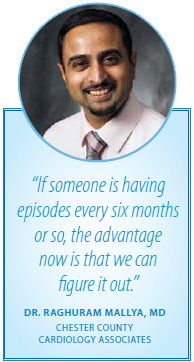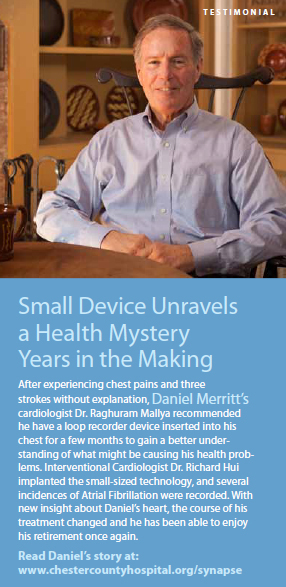Published: Synapse 2015 Vol. 2
A patient has multiple episodes of fainting and ends up in the hospital 15 times, but all tests come back normal.
Another comes into the Emergency Department with a stroke and is treated, but doctors cannot identify why the blood supply to the brain was interrupted: there is no evidence of a blood clot, artery blockage, or vessel disease.
Doctors might suspect a heart rhythm problem such as atrial fibrillation, or A-fib, a quivering or irregular heartbeat arrhythmia) that can lead to blood clots, stroke, heart failure, and other heart-related complications. The fainting also could be happening because the heart is beating too slowly or too quickly. Abnormal heart rhythms tend to come and go, though, and they are not always picked up while a patient is on a heart monitor in a hospital room or doctor's office.
 These two patients were real cases at Chester County Hospital treated by Hope Helfeld, DO, a cardiologist who specializes in heart rhythm disorders. She was able to help them thanks to a new device known as the Reveal LINQ, an insertable cardiac loop recorder. The monitor is about the size of a flattened pen cap -- an inch long and a quarter-inch wide -- and can be inserted under the skin of the chest using a small injecting device, where it continuously tracks a patient's heart rate and rhythms.
These two patients were real cases at Chester County Hospital treated by Hope Helfeld, DO, a cardiologist who specializes in heart rhythm disorders. She was able to help them thanks to a new device known as the Reveal LINQ, an insertable cardiac loop recorder. The monitor is about the size of a flattened pen cap -- an inch long and a quarter-inch wide -- and can be inserted under the skin of the chest using a small injecting device, where it continuously tracks a patient's heart rate and rhythms.
"What's great is that it takes less than five minutes to implant and you don't need general anesthesia, just a local numbing solution, and you can do it in the holding area of the cath lab. You put steri-strips on and the person goes home -- that's it," says Dr. Helfeld. "They take with them a bedside monitoring device that sends the 24/7 information from the LINQ monitor wirelessly to their doctor. I can even get an alert or text message if there is a heart rhythm event; I don't have to be in the office."
Patients can also wirelessly notify their cardiologist if they feel like they are having symptoms that should be noted right
away. Another benefit is the monitor's battery life: it lasts for three years, which is helpful for picking up heart rhythm abnormalities that occur only on occasion. In the case of Dr. Helfeld's patient with fainting episodes, the monitor diagnosed episodes of bradycardia, an abnormally slow heartbeat that was corrected by implanting a pacemaker. The patient with unexplained stroke was found to have paroxysmal atrial fibrillation, which simply means that the A-fib occurs spontaneouslyand then resolves over and over again. A-fib increases the risk of a blood clot forming in the heart and traveling into the brain, where it can cause a stroke. That patient is now taking a blood thinner to reduce this risk.
"These were definitely cases where I thought, 'Wow, I am so happy I used this device,'" says Dr. Helfeld.
 Although continuous heart monitoring was possible in the past, the equipment was less than ideal. Patients could wear some type of external monitor, but the devices were cumbersome, with multiple wires and adhesive patches, and only lasted for two to four weeks. If an arrhythmia did not occur during that time, it would remain undetected. For longer-term monitoring, patients could have minor surgery to get a cardiac monitor implanted in the chest, but physicians had to weigh the risks of surgery against the possibility of benefit. Cardiologist Raghuram G. Mallya, MD, says it was difficult to recommend surgery without being able to guarantee that the monitor would pick up an abnormality.
Although continuous heart monitoring was possible in the past, the equipment was less than ideal. Patients could wear some type of external monitor, but the devices were cumbersome, with multiple wires and adhesive patches, and only lasted for two to four weeks. If an arrhythmia did not occur during that time, it would remain undetected. For longer-term monitoring, patients could have minor surgery to get a cardiac monitor implanted in the chest, but physicians had to weigh the risks of surgery against the possibility of benefit. Cardiologist Raghuram G. Mallya, MD, says it was difficult to recommend surgery without being able to guarantee that the monitor would pick up an abnormality.
With the new insertable Reveal LINQ monitor, that dilemma has disappeared. "The fact that it can stay in for long periods of time is really the helpful piece," says Dr. Mallya. "If a patient is having episodes of arrhythmia daily, the condition is easy to diagnose and treat. But if someone is having episodes every six months or so, the advantage now is that we can figure it out."
Dr. Mallya notes that evidence from research studies is supporting the use of continuous loop monitors over external monitors, especially when it comes to picking up atrial fibrillation as a cause of unexplained stroke (the medical term is "cryptogenic stroke"). According to the American Heart Association, about 20 to 30 percent of strokes are cryptogenic, and not knowing the underlying cause hampers physicians' ability to prevent a future stroke. Being able to detect
A-fib by inserting a small monitor under the skin rather than surgically implanting it is a great advantage, Dr. Mallya says. Patients can take blood-thinning medication to prevent the A-fib-related blood clots that can lead to stroke. They also can take other medications to normalize heart rhythms. If nothing abnormal turns up over time, physicians can rule out a rhythm problem and look for other causes.
 A patient of Dr. Mallya, Daniel Merritt was the first person to have the Reveal LINQ monitor inserted at Chester County Hospital just over a year ago. For several years, Merritt had experienced unexplained episodes of chest pain, shoulder pain, nausea, and eye floaters, but medical tests came back normal. In 2013, when he slurred his words and had trouble speaking, MRI images revealed that he had suffered two strokes, but the cause of his problems remained a mystery. After more inconclusive tests, Dr. Mallya ultimately recommended the LINQ monitor, which was inserted in July 2014 and within a few months revealed that Merritt was indeed having episodes of atrial fibrillation. He is now taking medications for the condition.
A patient of Dr. Mallya, Daniel Merritt was the first person to have the Reveal LINQ monitor inserted at Chester County Hospital just over a year ago. For several years, Merritt had experienced unexplained episodes of chest pain, shoulder pain, nausea, and eye floaters, but medical tests came back normal. In 2013, when he slurred his words and had trouble speaking, MRI images revealed that he had suffered two strokes, but the cause of his problems remained a mystery. After more inconclusive tests, Dr. Mallya ultimately recommended the LINQ monitor, which was inserted in July 2014 and within a few months revealed that Merritt was indeed having episodes of atrial fibrillation. He is now taking medications for the condition.
Janice Baker, MSN, RN, CEPS, FHRS, cardiovascular clinical nurse manager and educator at Chester County Hospital, has worked with many patients who have had the Reveal LINQ monitor since then. In about 60 to 80 percent of cases where patients have unexplained symptoms -- ranging from heart palpitations, shortness of breath, chest pain, or passing out to symptoms of a possible stroke -- she says that the monitor can pick up a heart rhythm problem that has not appeared on an in-office electrocardiogram (EKG ). This empowers the care team to be proactive for patients and treat their troublesome and even life-threatening symptoms.
"If you can find and treat an arrhythmia, you can really have an impact on a patient's quality of life," Baker says. "What makes this monitor such a game changer is that research supports the conclusion that uncaptured arrhythmias are creating problems for patients -- problems as serious as stroke. Recently there has been significant change in how we look at patients who had a stroke or a transient ischemic attack [TIA or a temporary loss of blood supply to the brain that causes stroke-like symptoms but no permanent damage]. The focus is on figuring out what caused it so you can prevent another one from happening. This technology allows us to track down and identify the problem for patients before they have a devastating outcome."
By Kristine M. Conner